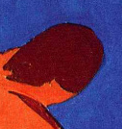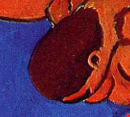Enjoying "La Danse"?
- romainfaure46
- 3 avr. 2023
- 3 min de lecture

One can study a work of art with expertise. Alternatively, one can “naively” contemplate it without any artistic or critical training and, step by step, find what amazes us, what moves us in it, or simply what it singularly evokes for us.
It is this approach that I propose to share with you here.

Although La Danse is one of Matisse's best-known works, I have never studied it or read any articles about it. I only know that this painting has a "twin", La Musique, painted in 1910.
So what can I say, as a humble layman, ignorant of the art world ?
La Danse touches me because it evokes an ideal. An ideal of peace, freedom and harmony, but perhaps even more so the poetic ideal of life’s expression : to me La Dance is life celebrating itself, joy kindled by human contact, individual grace that combines with others’ into an even greater collective grace.
Why ?
The five characters in the scene are naked and each has their own movement or gesture, and none seem to be looking at the others: it is as if their gaze was turned towards the ground (perhaps towards Mother Earth?). They are therefore free and individualized.
Yet, through their joined hands, a universal bond is established (or rather is in the process of being established, as the two hands in the foreground are not joined yet but are reaching towards each other).

This link is that of the round dance, which for me evokes peace, harmony and equality: one can think of King Arthur's round table, the circularity of parliaments’ hemicycles and perhaps even, pushing the speculation a little too far, associate the five characters with the five continents. But the round also reminds me of eternity and the cyclical nature of life. Hands come together, the circle closes, harmony is achieved once and for all.
And the colours in all this?
La Dance is also the harmony of three colours: blue represents the sky or Space, green the ground or the Earth, and a kind of orangey red is used for the dancers, or Life. The complementarity of those colours (red and green, orange and blue) perhaps reflects the complementarity between life and the universe, the sky and the earth within which life resides and expresses itself.
A word about balance, a key element to dancing.

Apart from the central character in the foreground who seems to float as they spring towards the character on the left to give them their hand, all the figures seem to have one foot on the ground and one foot in the air, as if a part of them belonged to the "green" element and another part to the "blue" element, in balance.
In addition, the leftmost character, taller than the others, seems to span the two elements as if they were between sky and earth. In this round of five, the eye sees three "sky-side" dancers and three "earth-side" dancers! The sense of balance in the painting is further heightened collectively by the symmetry of the circle formed by the dancers between green and blue, but also individually by each dancer’s feet position.
A final word?
These brightly complexioned androgynous characters who dance in a closing round and on a ground shaped like a planet, perhaps represent the symbol of human life that aims at finding its meaning in its own celebration. The ideal of existence may simply be existence celebrating itself through the joyous link of diverse existences: a dancing existence.
Bonus: (here, after doing some research*...)

A very similar dance scene (involving six dancers) is portrayed in another one of Matisse’s paintings, La Joie de vivre or Le Bonheur de vivre, completed earlier in 1906 where the theme of music is also preponderant.

* Source https://en.wikipedia.org/wiki/Le_bonheur_de_vivre








Commentaires